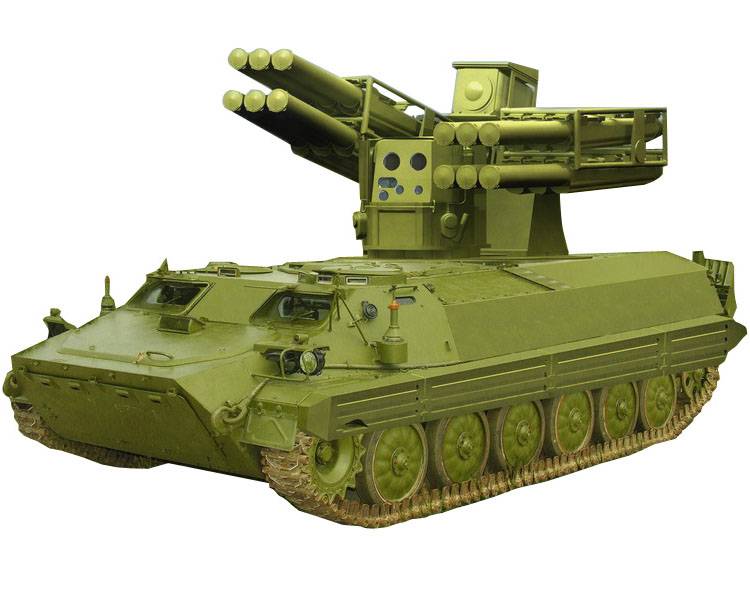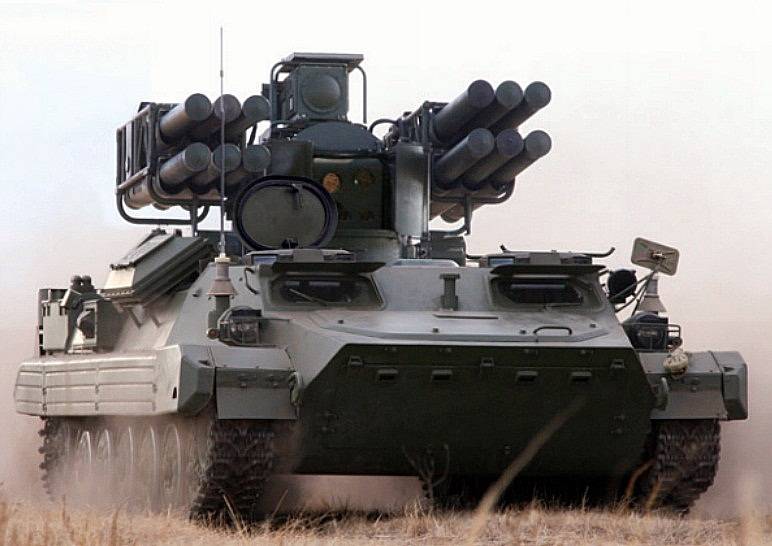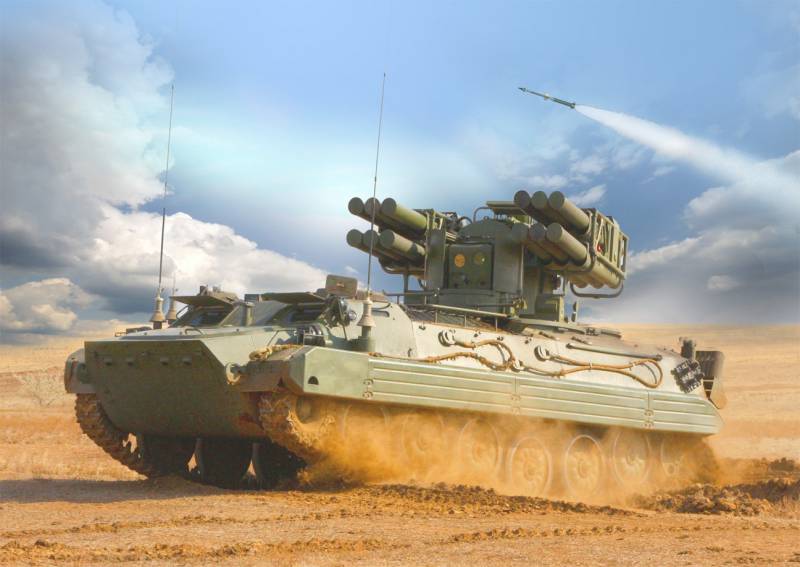Project "Pine". On the way to the series and the troops
The most important news about the Pine air defense missile system and related developments 29 March arrived. RIA Novosti has published an interview with the managing director of the Design Bureau of Precision Engineering. A.E. Nudelman Valeriy Makeev. The head of the company spoke about ongoing work, as well as the completion of the main activities on the most important modern projects.
One of the current developments of Tochmash Design Bureau is the Sosna air defense missile system, which was first shown to the public at last year's Army-2018 exhibition. This development, allegedly, has a number of positive qualities. The complex is distinguished by high efficiency and accuracy of hitting air targets, high survivability, full automation of processes and minimal reaction time. Also, the air defense missile system of this type shows the maximum range of damage among all existing systems with a laser-beam missile control system.
According to V. Makeev, to date, the Sosna air defense missile system has successfully completed state tests. Now the organizations of the defense industry and the Ministry of Defense are holding the measures necessary for putting the complex into service.
In the context of the Pine air defense system, the managing director mentioned another new development. For example, in the last three years, Tochmash Design Bureau has carried out research and development work to create a promising optical circular survey electronic station. The project envisages the creation of an ECO capable of tracking the environment, finding and maintaining air targets. The station is able to simultaneously track up to fifty objects, determine their coordinates, and also give target designation to other anti-aircraft weapons.
Prospective ECO can be built in land and sea versions, suitable for work on different platforms. Particularly noted option with the installation of such equipment on the self-propelled SAM "Pine". In this case, the latter is transformed into a unique anti-aircraft complex with fully passive means of detection, providing the greatest possible survivability on the battlefield. The absence of any radiation will seriously complicate the detection and identification of such an air defense system, necessary for its subsequent destruction.
This ROC is close to completion by now. Were also conducted state trials, which ended in success. In the near future a decision should be made on the adoption of the ECO in the supply of the armed forces. At the same time, V. Makeev spoke about the possibility of the appearance of such a document in the last days of March.
The Managing Director of the developer company also mentioned the commercial prospects of the Sosna air defense system. To date, even before the appearance of an order for mass deliveries of the Russian army, third parties were interested in this development. There are already applications, but it is not specified yet which countries they submitted.

General view of the combat vehicle. Photo NPO "High-precision complexes" / npovk.ru
It is curious that in the near future the development of a new air defense system can begin. V. Makeev said that the Ministry of Defense is currently conducting research on the further development of air defense weapons and weapons of the ground forces. During 2019, the Ministry of Defense specialists will form requirements for future air defense systems, and the Tochmash Design Bureau plans to take part in the further development of real samples.
***
According to the latest reports, the newest SIRS air defense missile system successfully coped with the tests and should soon enter service with the Russian army. Then parts of the ground forces will receive the first production samples of such equipment. Together with the latest machines, the army will have to get some new opportunities directly related to the characteristic features of the proposed complex.
According to the well-known data, “Sosna” is intended for military air defense, as part of which it should provide protection for ground forces on the march, in concentration places and in a combat situation. SAM is responsible for the defeat of a wide range of targets located at ranges up to 10 km and altitudes up to 5 km. "Pine" is intended to combat low-flying aircraft and helicopters in a jump, as well as aviation means of destruction of various types.
The “Pine” air defense missile system is intended to work as part of a layered military air defense system. Its task is to protect the near zone by hitting targets that have broken through other defense elements. For more effective work, “Pine” may be included in the existing communication and control systems providing target designation from third-party sources.
Declared increased survivability on the battlefield, provided the characteristic features of the combat vehicle, its equipment and weapons. For the detection and tracking of air targets, an integrated optoelectronic station with a laser rangefinder is used. An additional ECO has also been developed with a completely passive principle of operation. Such equipment does not use radio waves, which eliminates its detection by means of electronic reconnaissance. Consequently, the probability of hitting air defense complexes is sharply reduced.
The rocket armament is controlled by a laser beam directed at the target. The rocket is automatically held in the beam, and the receiving devices are located in its tail section. Such control principles exclude the possibility of disrupting the attack of missiles using electronic warfare systems, as well as render useless the means of optoelectronic suppression.

SIRS "Pine" at the site. Photo Rbase.new-factoria.ru
According to open data, a full-time ECO of the Sosna complex is capable of taking on airborne targets at ranges up to 25-30 km, depending on their type. Combat work is carried out in automatic or semi-automatic mode. In both cases, most of the various operations are performed by automation, which reduces the burden on the operator and increases the efficiency of his actions. The minimum reaction time is 5 seconds. Improved electronics provides the ability to fire both with a stop, and during movement.
The ammunition set of the Sosna air defense missile system consists of 12 3М340 Sosna-R guided missiles in transport and launch containers on two launchers of a combat vehicle. TPK mounts provide vertical guidance from -5 ° to + 82 °. The combat module allows you to fire in any direction.
SAM 9М340 differs in weight, reduced to 30, (40 kg in TPK), which made it possible not to introduce into the complex a separate transport-charging machine. The rocket is equipped with a solid-fuel engine that provides flight speeds up to 900 m / s. The design of the warhead is optimized for best performance. Undermining is carried out by a contact-proximity fuse with a laser target sensor. Guidance is carried out using a laser beam aimed at the target.
The Sosny equipment is performed in a block-modular form, which allows it to be mounted on different chassis with a lifting capacity of at least 3,5 m. The Sosna air defense system for the Russian army is based on the MT-LB serial chassis. The combat module of the complex is mounted on-site combat / amphibious chassis. According to some reports from the recent past, the Pine module is planned to be used as part of the Ptitselov air defense missile system intended for airborne troops. In this case, it will be mounted on one of the chassis, operated in the Airborne Forces.
***
From the point of view of origin, the newest Pine air defense missile system is a variant of the deep modernization of the older Strela-10М3 system. At the same time, it is considered as a replacement for all existing complexes of the Strela-10 family, which no longer fully meet modern requirements. According to open data, in the Russian ground forces now there are about 400 combat vehicles "Strela-10" of all major modifications. In the foreseeable future, they need to be replaced with modern samples.
Known data allow us to present the approximate volumes of future orders for the Sosny batch production. Apparently, in the next few years, the industry will have to build and transfer to the army at least several hundred anti-aircraft complexes of a new type. The increase in efficiency in comparison with the available equipment makes it possible in some way to reduce the required fleet of “Sosna” air defense missile systems, but in this case also large numbers of combat vehicles are required.

Guidance TPK with rockets. Photo Rbase.new-factoria.ru
Also in the context of the transfer of military air defense system to the complex "Pine" should remember the air defense system line "Wasp". This technique, having fighting qualities at the level of "Arrow-10", differs a considerable age. More than 400 combat vehicles of the latest modification of the Osa-AKM remain in the troops. It is likely that the new Pine air defense missile system will have to replace the old “Wasps”. In this case, the volume of orders for mass production will increase significantly.
According to the leadership of KB Tochmash, foreign armies have already become interested in the new domestic development, but the details of this are unknown. It is known that the air defense systems of the Strela-10 family are in service with 17 foreign countries, and 16 continue to operate the Osa vehicles of various modifications. Some of the countries interested in upgrading military air defense can turn to Russia for help and purchase the newest Pine system.
***
Thus, the latest news about the Pine air defense system speaks about the completion of one long and difficult phase of work, as well as the imminent start of another, no less difficult and important. Development work completed, passed state tests. Now it is expected the official adoption of the complex and the launch of mass production. In the future, production of serial equipment for foreign customers is possible.
In the near future, along with the latest serial SOSNA air defense systems, the Russian army will receive a number of opportunities and advantages. First of all, she will be able to update the fleet of military vehicles of the army air defense. In addition, it will be possible to increase the potential of air defense in the near zone due to the growth of tactical and technical characteristics and risk reduction. In the future, modern developments can lead to a partial unification of the equipment of the ground forces and the Airborne Forces with known positive consequences.
The completion of the development and successful conduct of state tests of the Sosna air defense missile system is the most important event in modern stories domestic military air defense. On the basis of new ideas and modern components, an improved complex has been created, and soon it will have to enter the army.
On the materials of the sites:
https://ria.ru/
https://tass.ru/
https://russian.rt.com/
http://kbtochmash.ru/
http://npovk.ru/

Information